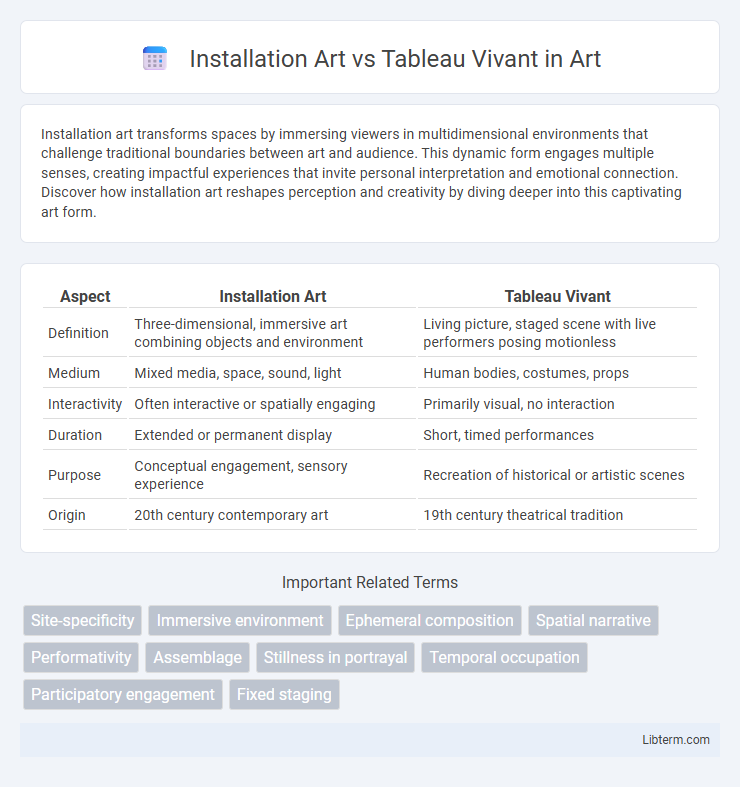Installation art transforms spaces by immersing viewers in multidimensional environments that challenge traditional boundaries between art and audience. This dynamic form engages multiple senses, creating impactful experiences that invite personal interpretation and emotional connection. Discover how installation art reshapes perception and creativity by diving deeper into this captivating art form.
Table of Comparison
| Aspect | Installation Art | Tableau Vivant |
|---|---|---|
| Definition | Three-dimensional, immersive art combining objects and environment | Living picture, staged scene with live performers posing motionless |
| Medium | Mixed media, space, sound, light | Human bodies, costumes, props |
| Interactivity | Often interactive or spatially engaging | Primarily visual, no interaction |
| Duration | Extended or permanent display | Short, timed performances |
| Purpose | Conceptual engagement, sensory experience | Recreation of historical or artistic scenes |
| Origin | 20th century contemporary art | 19th century theatrical tradition |
Introduction to Installation Art and Tableau Vivant
Installation art transforms a space into an immersive, multi-sensory experience that often incorporates various materials and media to engage viewers physically and emotionally. Tableau vivant, in contrast, is a staged, silent representation of a scene or story using live actors arranged to mimic a painting or sculpture, emphasizing visual composition and narrative. Both art forms prioritize spatial presence but differ in interaction: installation art invites exploration, while tableau vivant centers on static, deliberate portrayal.
Historical Origins and Development
Installation art originated in the early 20th century, evolving from avant-garde movements such as Dada and Surrealism to create immersive, three-dimensional environments that engage multiple senses. Tableau vivant, emerging in the Renaissance and gaining popularity in the 19th century, involved live models posed to represent scenes from literature, history, or mythology, emphasizing visual storytelling and theatricality. While installation art continuously expands through experimental media and participatory experiences, tableau vivant remains rooted in staged, static representations focusing on visual composition and narrative reenactment.
Defining Features of Installation Art
Installation art transforms a space using immersive, multisensory elements that engage viewers physically and emotionally, often employing diverse media like sculpture, video, sound, and light. Unlike tableau vivant, which presents static, staged scenes or living pictures emphasizing performative representation, installation art emphasizes spatial interaction and environmental presence. Key features include site-specificity, viewer participation, and the creation of dynamic experiences that challenge conventional art boundaries.
Key Elements of Tableau Vivant
Tableau Vivant emphasizes live, posed human figures creating a frozen scene inspired by paintings, sculpture, or literature, engaging viewers through direct visual storytelling. Key elements include meticulous costumes, precise choreography, and expressive body language that convey emotional depth and narrative clarity without movement or speech. Unlike Installation Art, which prioritizes immersive spatial environments and interactive components, Tableau Vivant relies on stillness, theatricality, and historical references to evoke meaning.
The Role of Space and Environment
Installation art transforms physical space into an immersive environment, actively engaging viewers through spatial interaction and sensory experience. Tableau vivant relies on meticulously staged human figures within a defined setting, emphasizing visual composition and narrative within a fixed space. The role of space in installation art is dynamic and enveloping, whereas in tableau vivant, it is structured and representational, highlighting the contrast between participatory and performative use of the environment.
Interaction and Audience Engagement
Installation Art transforms physical spaces into immersive environments, actively inviting audience participation and sensory experiences that evolve with viewers' movements and interactions. Tableau Vivant presents meticulously staged scenes with performers holding static poses, emphasizing visual storytelling and theatricality while maintaining a deliberate separation between the audience as observers and the performers. The contrasting engagement models highlight Installation Art's dynamic interactivity versus Tableau Vivant's contemplative observation.
Temporality and Permanence in Both Forms
Installation art often embraces temporality through its immersive, site-specific arrangements designed to exist temporarily within a space, while tableau vivant captures a momentary stillness, freezing performers in a scene for a brief, staged duration. The permanence of installation art varies widely from ephemeral exhibits to lasting museum collections, contrasting with tableau vivant's inherently transient performance tied to live interaction and audience presence. Both forms challenge traditional notions of art's duration, with installation art altering environments over time and tableau vivant emphasizing the fleeting nature of theatrical representation.
Materials and Mediums Used
Installation art often incorporates diverse materials such as found objects, multimedia components, and interactive technology to create immersive spatial experiences. Tableau vivant relies primarily on live performers, costumes, and props arranged to imitate scenes from paintings or historical events, emphasizing the human form as the main medium. While installation art engages multiple senses through varied materials, tableau vivant centers on visual storytelling through static yet dynamic human representation.
Contemporary Artists and Notable Works
Installation art, exemplified by artists such as Yayoi Kusama with her immersive "Infinity Mirror Rooms," creates multi-sensory environments that engage viewers spatially and conceptually. Tableau vivant, revitalized by contemporary artists like Marina Abramovic in works such as "The Artist Is Present," involves live, static scenes that emphasize performance and presence in real time. Both forms redefine traditional art boundaries, with installation art prioritizing experiential immersion and tableau vivant focusing on the theatrical depiction of living pictures.
Impact on Modern Art and Cultural Discourse
Installation art transforms spatial experience by immersing viewers in multisensory environments, challenging traditional art boundaries and encouraging active engagement. Tableau vivant, with its static, staged representation of living scenes, emphasizes historical narrative and theatricality, often evoking cultural memory and social commentary. Both forms significantly influence modern art and cultural discourse by redefining audience interaction and expanding the scope of artistic expression beyond conventional media.
Installation Art Infographic

 libterm.com
libterm.com